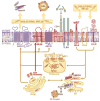Intracellular lipid flux and membrane microdomains as organizing principles in inflammatory cell signaling
- PMID: 21810617
- PMCID: PMC3151145
- DOI: 10.4049/jimmunol.1100253
Intracellular lipid flux and membrane microdomains as organizing principles in inflammatory cell signaling
Abstract
Lipid rafts and caveolae play a pivotal role in organization of signaling by TLR4 and several other immune receptors. Beyond the simple cataloguing of signaling events compartmentalized by these membrane microdomains, recent studies have revealed the surprisingly central importance of dynamic remodeling of membrane lipid domains to immune signaling. Simple interventions upon membrane lipid, such as changes in cholesterol loading or crosslinking of raft lipids, are sufficient to induce micrometer-scale reordering of membranes and their protein cargo with consequent signal transduction. In this review, using TLR signaling in the macrophage as a central focus, we discuss emerging evidence that environmental and genetic perturbations of membrane lipid regulate protein signaling, illustrate how homeostatic flow of cholesterol and other lipids through rafts regulates the innate immune response, and highlight recent attempts to harness these insights toward therapeutic development.
Figures


References
-
- Simons K, Ikonen E. Functional rafts in cell membranes. Nature. 1997;387:569–572. - PubMed
-
- Jacobson K, Mouritsen OG, Anderson RG. Lipid rafts: at a crossroad between cell biology and physics. Nat Cell Biol. 2007;9:7–14. - PubMed
-
- Simons K, Gerl MJ. Revitalizing membrane rafts: new tools and insights. Nat Rev Mol Cell Biol. 2010;11:688–699. - PubMed
-
- Lingwood D, Simons K. Lipid rafts as a membrane-organizing principle. Science. 2010;327:46–50. - PubMed
Publication types
MeSH terms
Substances
Grants and funding
LinkOut - more resources
Full Text Sources
Other Literature Sources
Medical

